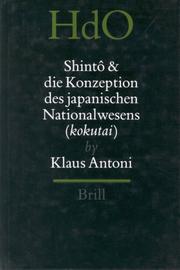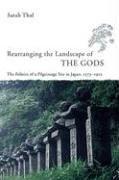| Listing 1 - 5 of 5 |
Sort by
|
Book
ISBN: 9781933947891 9781933947693 Year: 2013 Publisher: Ithaca Cornell university. East Asia program
Abstract | Keywords | Export | Availability | Bookmark
 Loading...
Loading...Choose an application
- Reference Manager
- EndNote
- RefWorks (Direct export to RefWorks)
This is a partial translation of one of the most important texts produced by Motoori Norinaga. It covers a wide range of Norinaga's thought and provides a lens onto his philological methodology, as well as how he viewed literature, poetry, history, linguistics, and Shinto.
J1560 --- J1450 --- J5500.60 --- J1913.60 --- J1910.60 --- Japan: Philosophy -- individual philosophers -- Kinsei, Edo, Tokugawa period, early modern (1600-1867) --- Japan: Philosophy -- kokugaku, Japanism, Yamatoism --- Japan: Literature -- history and criticism -- Kinsei, Edo, Tokugawa period, early modern (1600-1867) --- Japan: Religion -- Shintō -- sects and schools -- traditional -- fukko, kodō, kokugaku shintō --- Japan: Religion -- Shintō -- history -- Kinsei, Edo, Tokugawa period, early modern (1600-1867)
Book
ISBN: 9781350066540 9781474271080 1474271081 1350066540 Year: 2018 Publisher: London Bloomsbury Academic
Abstract | Keywords | Export | Availability | Bookmark
 Loading...
Loading...Choose an application
- Reference Manager
- EndNote
- RefWorks (Direct export to RefWorks)
"Yijiang Zhong analyses the formation of Shinto as a complex and diverse religious tradition in early modern Japan, 1600-1868. Highlighting the role of the god Okuninushi and the mythology centered on the Izumo Shrine in western Japan as part of this process, he shows how and why this god came to be ignored in State Shinto in the modern period. In doing so, Zhong moves away from the traditional understanding of Shinto history as something completely internal to the nation of Japan, and instead situates the formation of Shinto within a larger geopolitical context involving intellectual and political developments in the East Asian region and the role of western colonial expansion. The Origin of Modern Shinto in Japan draws extensively on primary source materials in Japan, many of which were only made available to the public less than a decade ago and have not yet been studied. Source materials analysed include shrine records and object materials, contemporary written texts, official materials from the national and provincial levels, and a broad range of visual sources based on contemporary prints, drawings, photographs and material culture"--
J1912.19 --- J1910.60 --- J1910.70 --- Japan: Religion -- Shintō -- history -- Kinsei, Edo, Tokugawa period, early modern (1600-1867) --- Japan: Religion -- Shintō -- history -- Kindai (1850s- ), bakumatsu, Meiji, Taishō --- J1912.90 --- Shinto --- Ōkuninushi no kami. --- History --- Japan --- Religion --- HISTORY --- RELIGION --- Religion. --- Schintoismus. --- Shinto. --- Staat. --- Ōkuninushi no kami. --- Buddhism --- History. --- Shintoism. --- Izumo-Schrein. --- To 1868. --- Japan. --- Japan: Religion -- Shintō -- kami
Book
ISBN: 9781350181069 9781350181083 Year: 2021 Publisher: London : Bloomsbury,
Abstract | Keywords | Export | Availability | Bookmark
 Loading...
Loading...Choose an application
- Reference Manager
- EndNote
- RefWorks (Direct export to RefWorks)
"This book sheds new light on the relationship between religion and state in early modern Japan, and demonstrates the growing awareness of Shinto in both the political and the intellectual elite of Tokugawa Japan, even though Buddhism remained the privileged means of stately religious control. The first part analyses how the Tokugawa government aimed to control the populace via Buddhism and at the same time submitted Buddhism to the sacralization of the Tokugawa dynasty. The second part focuses on the religious protests throughout the entire period, with chapters on the suppression of Christians, heterodox Buddhist sects, and unwanted folk practitioners. The third part tackles the question of why early Tokugawa Confucianism was particularly interested in 'Shinto' as an alternative to Buddhism and what 'Shinto' actually meant from a Confucian stance. The final part of the book explores attempts to curtail the institutional power of Buddhism by reforming Shinto shrines, an important step in the so called ?Shintoization of shrines? including the development of a self-contained Shinto clergy." Introduction: Tokugawa Religious Orthopraxy and the Phenomenon of Domain Shinto, Bernhard Scheid -- Part 1: Tokugawa Orthopraxy -- 1. Anti-Christian Temple Certification ( terauke ) in Early Modern Japan: Establishment, Practice, and Challenges, Nam-lin Hur (University of British Columbia, Canada) -- 2. Ieyasu's Posthumous Title and the Tokugawa Discourse on ?Divine Country," Sonehara Satoshi (Tohoku University, Japan) -- Part 2: Unwanted Religious Groups -- 3. Anti-Christian Measures and Religious Institutions in the Nagasaki Port City in the Early Edo Period (1614-1644), Carla Tronu (University of Kyoto, Japan) -- 4. When the Lotus went Underground: the Nichiren Buddhist Fujufuse Movement and its Early Modern Persecution, Jacqueline I. Stone (Princeton University, USA) -- 5. 'Deviant Practices' and 'Strange Acts': Late Tokugawa Judicial Perspectives on Heteropraxy, Kate Wildman Nakai (Sophia University, Japan) -- Part 3: Intellectual Challenges --
Religion and state --- Religion and state. --- Shinto and state --- Shinto and state. --- Shinto --- Shinto. --- History --- History. --- Japan. --- J1910.60 --- J1917.70 --- State and Shinto --- State, The --- Japan: Religion -- Shintō -- history -- Kinsei, Edo, Tokugawa period, early modern (1600-1867) --- Japan: Religion -- Shintō -- relations -- State, state Shintō

ISBN: 9004103163 9004488499 Year: 1998 Volume: 8 Publisher: Leiden Brill
Abstract | Keywords | Export | Availability | Bookmark
 Loading...
Loading...Choose an application
- Reference Manager
- EndNote
- RefWorks (Direct export to RefWorks)
Shinto and state --- Kokutai --- Shinto et Etat --- 299.52 --- J1942 --- J1970.70 --- J1008 --- State and Shinto --- State, The --- Emperors --- Godsdiensten van Japan. Shintoisme --- Japan: Religion -- Shintō -- relation with politics and state, Shintō as national polity (kokutai) --- Japan: Religion -- Shintō -- history -- Kindai (1850s- ), bakumatsu, Meiji, Taishō --- Japan: Philosophy -- history --- 299.52 Godsdiensten van Japan. Shintoisme --- J1910.70 --- J1917.70 --- Japan: Religion -- Shintō -- relations -- State, state Shintō --- J1910.60 --- Japan: Religion -- Shintō -- history -- Kinsei, Edo, Tokugawa period, early modern (1600-1867) --- Shintō et Etat

ISBN: 0226794202 0226794210 9780226794211 9780226794204 Year: 2005 Publisher: Chicago (Ill.) : University of Chicago press,
Abstract | Keywords | Export | Availability | Bookmark
 Loading...
Loading...Choose an application
- Reference Manager
- EndNote
- RefWorks (Direct export to RefWorks)
When people create new societies, economies, and nations--both now and in the past--they create gods, rituals, and miracles to support them. Even what seem to be some of the most timeless and sacred sites in the world have been shaped, reshaped, and reinterpreted by countless people to produce oases of peace and nature today. Using miracle tales, votive plaques, diaries, and newspapers, Sarah Thal traces such changes at one of the most popular Japanese pilgrimage sites of the nineteenth and twentieth centuries: the shrine of Konpira on the island of Shikoku. This rich and fascinating history explores how people from all walks of life gave shape to the gods, shrines, and rituals so often attributed to ancient, indigenous Japan. Thal shows how worshippers and priests, rulers and entrepreneurs, repeatedly rebuilt and reinterpreted Konpira to reflect their needs and aspirations in a changing world--and how, in doing so, they helped shape the structures of the modern state, economy, and society in turn. 'Rearranging the Landscape of the Gods' will be welcomed by all scholars of Japanese history and by students of religion interested in the construction of modernity.
Konpira (Shinto deity) --- Kotohiragu (Kotohira-cho, Japan) --- Kotohiragū (Kotohora-chō, Japan) --- Kompira (Shinto deity) --- J1945.61 --- J1970.60 --- J1970.70 --- Japan: Religion -- Shintō -- shrines and pilgrimage -- Shikoku -- Kagawa prfecture (Sanuki) --- Japan: Religion -- Shintō -- history -- Kinsei, Edo, Tokugawa period, early modern (1600-1867) --- Japan: Religion -- Shintō -- history -- Kindai (1850s- ), bakumatsu, Meiji, Taishō --- Kotohiragū (Kotohira-chō, Japan) --- Konpira (Shinto deity). --- Kotohiragū (Kotohira-chō, Japan). --- J1910.60 --- J1910.70 --- J1918.61 --- Japan: Religion -- Shintō -- shrines and pilgrimage -- Shikoku region -- Kagawa prfecture (Sanuki) --- Konpira Daigongen (Shinto deity) --- Kumbhīra (Shinto deity) --- Gods, Shinto --- Kumbhīra (Buddhist deity) --- Kotohiragū (Kotohira-chō, Japan) --- Kotohira-chō (Japan). --- Kotohiragū, Kotohira-chō, Japan --- 琴比羅宮 (琴比羅町, Japan) --- 金刀比羅宮 (琴平町, Japan) --- 金刀比羅宮 (Kotohira-chō, Japan)
| Listing 1 - 5 of 5 |
Sort by
|

 Search
Search Feedback
Feedback About UniCat
About UniCat  Help
Help News
News